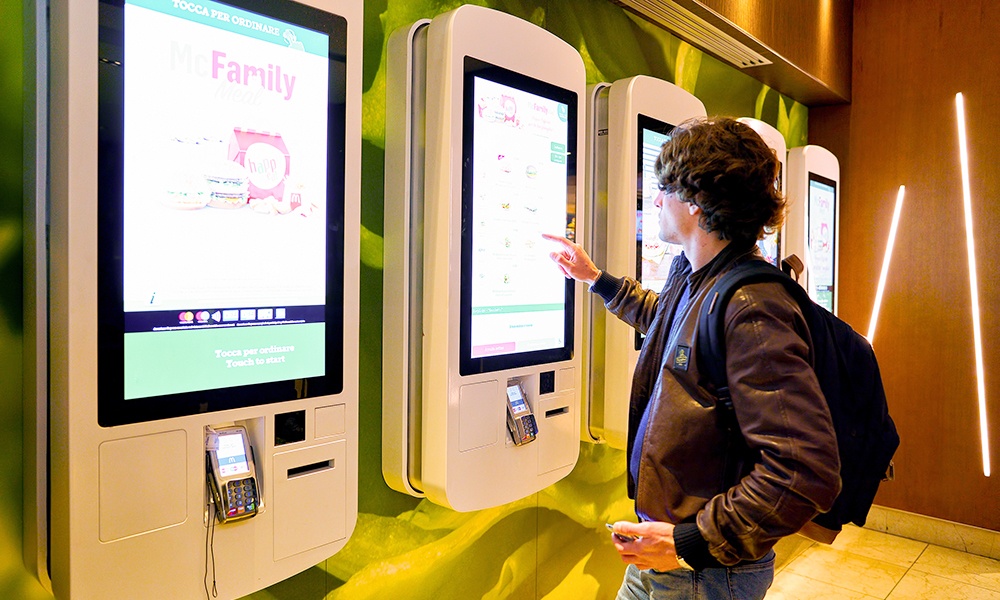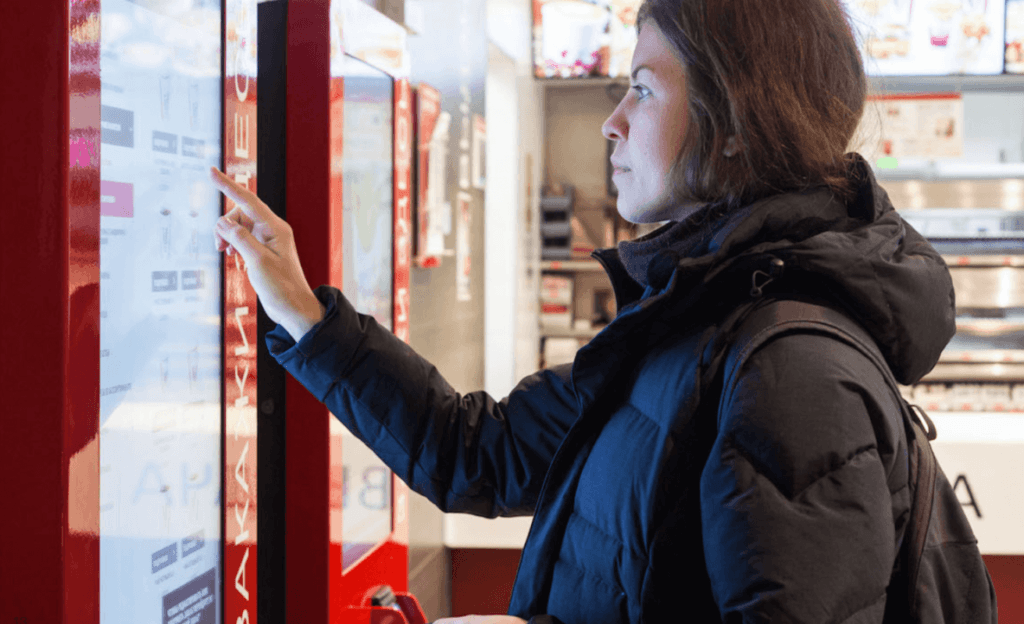These days, it seems that people will do anything to save a bit of time. Businesses and banks have been responding accordingly, offering new ways to pay that are both more secure and more time-friendly. One of the ways businesses have created a payment shortcut is by introducing self-service kiosks to their checkout lines.
You might have seen them during your last coffee run to McDonald’s or your last lunch break at Panera Bread. Rather than waiting in line for everyone to order one burger with everything, one burger with no pickles and one burger with ketchup only and then count out 72 cents after they’ve finished placing an order, you can pop your order into the freestanding kiosk, swipe your card and wait for the order to show up at your table a few minutes later.
They allow you to avoid wait times, but they also let you skip the small talk with the cashier. What’s more, because of the EMV technology they’re equipped with, they’re incredibly secure. They use the same chip reading hardware that you’ve seen in most businesses today.
Self-service kiosks seem like a great addition to the fast-food industry and convenience stores such as Walmart and Target, but do they really save as much time as they promise to? As a retail business owner, are they worth the investment? Here, we’ll help you answer those questions.
What do the numbers & real-world experience say about self-service kiosks popularity and checkout time speed?
There are a number of statistics that suggest self-service kiosks can improve checkout times and make customers happier. Since we all know numbers and quantifying impact is important, let’s check out a few interesting stats and reports:
- Consumers prefer self-service. According to a survey reported on in this Retail Customer Experience post, 66% of surveyed shoppers had a preference for self-service and self-checkout.
- Self-service is a winner for Quick Service Restaurants (QSRs). According to a survey Mobile Payments Today reported on, 60% of customers would visit a QSR or fast-casual restaurant more frequently if self-service kiosks were available.
- Self-service can boost spending. According to this pymnts.com article, customers spend 30% more when using self-service kiosks
- Self-service kiosks can boost speed. According to this Retail Customer Experience report, serving customers faster, improving customer satisfaction, and streamlining business processes are some of the ROI (return on investment) drivers of self-service kiosks.
If self-service kiosks promise speed, won’t everyone flock to them?
It’s clear: self-service kiosks can improve customer experience and speed of checkout. However, there are some potential tradeoffs to consider to see if they are right for your business.
It seems people prefer self-service, so won’t that mean everyone is going to get in line to use the kiosk? This could, in effect, make it slower than actually getting in line with a cashier.
While you might think this is the case, there are still plenty of customers who won’t make the switch to cashier-less paying. There are still those who prefer handing cash to someone who will then count out their change and tell them to have a good day.
For those who feel more comfortable dipping their card in a machine without a human present, the self-service kiosk will be a welcome part of their busy days. There might be a couple of people in line, but if they know what they want and they have their credit card ready, the line won’t last long.
Dipping does, on average, take a few seconds longer than swiping cards used to take. This is because the card needs to communicate with the acquiring bank in order for the transaction to be authenticated. This won’t take as long as counting exact change or signing receipts though.
Consider who will use the self-service kiosk
If your customers are tech-savvy, they may breeze through self-service kiosks. If they aren’t comfortable with technology, you’ll need to offer other options. If your customers can’t operate the kiosk effectively, it will lead to wasted time and frustration. This defeats the purpose.
There are two things you can do to avoid mistakes here:
- Know your customers. Don’t force tech on them that they will not understand.
- Make sure you use self-service kiosks with intuitive and easy to use software and hardware. Solutions like the VP6800 can go a long way here.
Self-service requires some maintenance
Technology has worked wonders in the way of creating simpler ways to complete tasks. Machines aren’t always perfect, though, and there will be times when they stop working or when they need some updates.
Computers have hardware and software that needs to be kept up-to-date in order to function properly and continue to run smoothly. If there is heavy traffic at a self-service kiosk and it hasn’t received the requisite amount of maintenance, there might be issues in terms of screen glitches, trouble printing receipts or problems with the hardware itself.
Naturally, this would require a human employee to step in and fix the problem. It might set you back a few minutes if the machine doesn’t read your card or doesn’t accept your crumpled bills. Keep in mind, however, that technological glitches are often not a regular occurrence and the machines won’t be out of service every time you try to use them.
Knowing when self-service makes sense
Have you traveled recently? Self-service kiosks aren’t only at gas stations and fast-food restaurants now. Airports have been installing them in terminals to save time when it comes to printing boarding passes and getting passengers checked into their flights.
They’ve been a great help for frequent fliers who don’t want to wait in lines behind families who are traveling with three children for the first time. It’s an easy way to get to security lines faster and avoid cutting it close to making a flight you might have been running late for.
If you’re the type of passenger who travels light for short flights and you don’t have checked back, depending on the airline, an attendant might still have to come to your kiosk to check the size of your carry on bag. So you saved time printing your own boarding pass, but you had to wait for the attendant to check the bag size of several other people ahead of you. There’s still a waiting element.
The takeaway here is: you have to understand the context of your business. Don’t force people into self-service if it will create bottlenecks and frustration. Use self-service kiosks where it makes things more convenient for your customers. Often this means a combination of self-service, “traditional” point of sale checkouts, and retail associates armed with mobile technology.
Self-Service kiosks are helpful if you know what you want
In terms of ordering food at your favorite chain, you probably know what you want when you run in to grab dinner. That makes for an easy experience at the kiosk and really makes it a time-saving experience for you.
Not everything you use self-service kiosks for might have the same outcome. Have you tried using a cashier- or attendant-free machine before and realized you don’t know how to use part of it or the machine asks you a question about your payment method that you don’t know the answer to?
A couple of years ago, USPS introduced self-service kiosks to their lobbies to help customers save time during the holidays, when lines to ship packages or mail bulk Christmas cards could be out the door. They couldn’t do everything the full-service counter could, but you could purchase stamps, weigh and ship packages and mail letters without waiting in line.
Something they couldn’t do? Answer your question about a returned letter or take your passport photo. Those things you’d have to wait in line and talk to an employee for, but in terms of straightforward mailing services, they certainly cut out long wait times.
Self-Service kiosks are modern express check out
You’ve probably been in line at any number of retail shops when you’ve had three things in your hand and you were stuck behind shoppers with carts full of merchandise.
If you had places to be or other errands to run with ice cream melting in the back seat, chances are high your foot was tapping in impatience. Self-service kiosks have done a great deal to help those shoppers who need speedy service. They can scan their own items, throw them all in a bag, dip their card and be on their way. They can even send their receipts to their emails instead of waiting for a printout.
Want to add self-service to your business?
When properly implemented, self-service can be a boon to your retail business.
At ID TECH, we have the most modern technology for unattended payments. Your customers can pay in cash, with credit or through a contactless tap. Check out our line of unattended payment solutions, or reach out to our team of point-of-sale experts if you have questions about how you can use them at your business.


